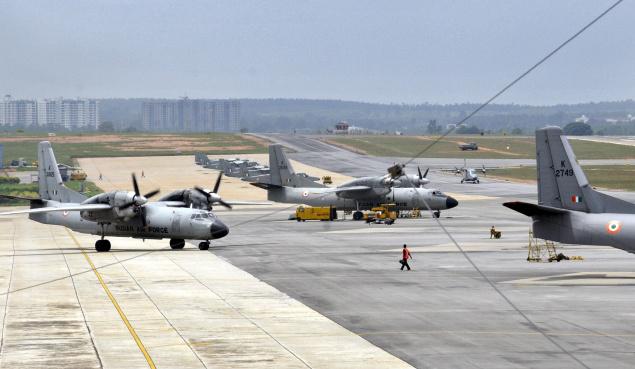BANGALORE, October 4: It is easily an occasion for a double celebration on this innocuously calm, green sprawl on the busy National Highway 7, but the air is subdued. Overhead in the campus, an occasional steel-grey helicopter whirrs about. Below, men and women in blue go about their businesses in buildings that are sheathed in tranquil blue and white.
When you visit the place outside the riotous two-yearly Aero India extravaganza, everything about Air Force Station Yelahanka, located some 20 km north of Bangalore city, belies the dangerous times it lives.
All of 50 years this year, the air base has hosted nine of these international air shows for the Ministry of Defence since 1993.
There is also a quiet sense of pride and heritage as the 81 Air Force Day – October 8 – draws close.
The Yelahanka air base continues to be a vital cog in producing trained pilots to fly the IAF’s transport planes and helicopters, according to Air Commodore S.P. Singh, who is its Air Officer Commanding.
As the Force expands its fleet with new generation transport planes like the C-130J and the C-7, the role of the training station can only grow, he said during a media open house at the air base on Thursday.
The Yelahanka air base was born in 1963 when the Air Force started strengthening its training operations just after the war with China. A World War II airfield was refurbished and the training base took off on August 1, 1963 with a first batch of transport plane pilots graduating out of here.
A helicopter unit was added in 192 and now the base houses four units. Today the IAF trains pilots for its AN-32 and Dornier 228 transport planes; and for the Mi-8 and Chetak copters.
Around 35 pilots are currently training on transport planes and another 20 on helicopters after basic stints, Air Commodore Singh said. Each year it produces some 350 pilots from all streams.
The station houses seven squadrons of transport plane and two squadrons of Mi-8 copters. All of which makes the station clock one of the IAF’s highest number of flying hours – 20,000.
Thoroughbred saviours
At the entrance to the 112 Helicopter Unit are scores of pictures of their heroes. One particular display dated September 2009 catches the eye. One of their men is `winching’ down a helicopter in forest clearing.
112 HU’s commanding officer, Wing Commander Manish Sharma, explained that it was a gunner coming down to retrieve the body of former Andhra Pradesh Chief Minister Y.S.Rajashekar Reddy who died in a helicopter crash near Kurnool. The unit called Thoroughbreds trains its personnel to save people, sometimes collect bodies from such disasters. It also turns out 50-100 flight engineers and gunners each year who go on to serve also on the IL-76, IL-78 and AN-32 planes.
One of the oldest IAF units, 112 HU doubles up with a wartime role such as in Kargil, Sri Lanka and Bangladesh; or supporting civil operations during cyclones, floods and VVIP movements.
Eagle’s eye
Yelahanka’s busy military Air Traffic Control, some five storeys high, keeps an eagle’s eye day and night on over 250 flight movements each day – both from its fleet and the commercial planes landing and taking off at the civil international airport 15 km up north, said its ATC, Wing Commander Ruhi Bhullar.
The air base of a perimeter of 12 km houses about 3,000 air officers and personnel. Just across the road are bustling set-ups of their families and amenities.

